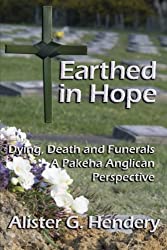
Earthed in Hope: Dying, Death and Funerals – A Pakeha Anglican Perspective (paperback)
Earthed in Hope (Kindle Edition)
By Alister G. Hendery
300 pages
Māori, the indigenous people of Aotearoa New Zealand, have a very down-to-earth approach to death. The Anglican Church in Aotearoa, New Zealand and Polynesia has been very open to being enriched from this tikanga (culture, custom). This means that A New Zealand Prayer Book He Karakia Mihinare o Aotearoa (ANZPB/HKMA), within a relatively small compass, provides rites, resources, and insights from before death, through being with the body (often at home), the funeral, prayers in the house after death, to the committal of ashes, and the unveiling of a memorial.
Now the Rev. Alister Hendery, out of a vast experience of funerals and counselling, and drawing on wide research, has written a book which thinks through dying, death, and bereavement. Archbishop Philip Richardson, in the Foreword, says, “I am going to place a copy of this book in the hands of every person I ordain from now on.” Certainly, this book, I think, is now the standard on this in New Zealand. But I also recommend it to people in quite different countries, cultures, and contexts, if only to set up a dialogue for what is appropriate for you, and to translate the insights into your own setting.
The book is honest and sensitive, acknowledging issues of spirituality ‘verses’ religion, and recognises that so much of our culture is death-denying and uses euphemisms. Alister is candid about the shift to celebrant-led and one-stop funeral events. He rightly challenges the stages-of-grief model that continues to be so widespread.
The book is very well organised, there are clear headings, subheadings, notes, and a helpful bibliography and index. I am honoured to be mentioned (with this website).
Alister discusses the Christian hope of life after death, and includes healthy reflection on doubt. ANZPB/HKMA (like so many funeral rites) uses language of “the sure and certain hope of the resurrection…” Such language may be appropriate in many contexts, but does it sound like overkill in some: “sure AND certain…” Similarly, I wonder about how the language of ANZPB/HKMA is heard in some contexts when we commend the dead person “to God’s judgment and …to God’s forgiveness…”
There is a sensitive chapter on suicide, a topic on which the church has done a full 180 degree turn in its approach.
In our NZ context, we are so used to Maori addressing those who have died (“E ngā mate, haere, haere, haere…”) that we may no longer notice the unusualness in our Prayer Book that we address the person who has died: “… we commend you, N, to… we commit your body to be buried/cremated…”
With a dearth of history and commentary associated with ANZPB/HKMA, Earthed in Hope immediately stands as the definitive work on Funeral Liturgies and Services in the Time of Death section of our Prayer Book. It provides ritual notes, and suggestions for adaptation. I am pleased to see that “At a funeral the Paschal (Easter) Candle, ‘symbolising Christ the light of the world, risen from the darkness of the grave,’ is lit and stands by the coffin. (pages 200, 227 – and in a different way 282). I think the idea of leading out with the Paschal candle (p227) revisions the use of that symbol, and should be added as an option to be raised with families. Sprinkling the coffin with holy water is mentioned immediately before the
Commendation or at the Committal as a long-held custom within some traditions (p226). Alister provides a prayer (I’m not sure the symbol needs more words, but it is good the option is provided). There appears to be no discussion about liturgical colour. I think colour needs to be thought through – my own usage is white.
I have no hesitation in heartily recommending this book to all involved in this important ministry. Thank you Alister.



